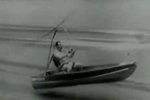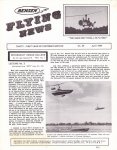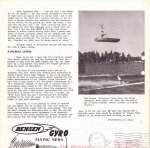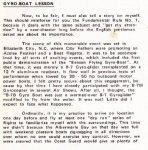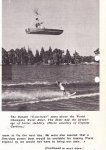You are using an out of date browser. It may not display this or other websites correctly.
You should upgrade or use an alternative browser.
You should upgrade or use an alternative browser.
Bensen
- Thread starter scandtours
- Start date
scandtours
scandtours
Any videos with Dr. Bensen flying his Gyro glider on boat?? Like the photos below.
Searched youtube and the only I could find is this..... scroll forward to 3.03.
It's just 2 seconds long.
www.youtube.com/watch?v=CVFEDccid_A&t=199s&list=FL0IvHABdYoalGjopmiT6baQ&index=2
Searched youtube and the only I could find is this..... scroll forward to 3.03.
It's just 2 seconds long.
www.youtube.com/watch?v=CVFEDccid_A&t=199s&list=FL0IvHABdYoalGjopmiT6baQ&index=2
Attachments
Doug Riley
Platinum Member
- Joined
- Jan 11, 2004
- Messages
- 6,998
The three small floats look like tip sponsons from an amphibian plane -- Seabee or some such thing. Imagine what they'd sell for today!
Bensen wrote an article in the PRA mag about an uncommanded dive he experienced in the Gyroboat. It foreshadowed the stability problems we have had with body pods on gyros when the tail surfaces have not been designed with a pod in mind.
Bensen wrote an article in the PRA mag about an uncommanded dive he experienced in the Gyroboat. It foreshadowed the stability problems we have had with body pods on gyros when the tail surfaces have not been designed with a pod in mind.
All_In
Gold Supporter
- Joined
- Apr 21, 2008
- Messages
- 16,105
- Location
- San Diego, CA. USA
- Aircraft
- Airgyro AG915 Centurian, Aviomania G1sb
- Total Flight Time
- Gyroplane 70Hrs, not sure over 10,000+ logged FW, 260+ ultralights, sailplane, hang-gliders
Thanks for the blast from the past.
When I was scanning in all the past magazines I saw the article and had to read it.
Read many of the articles one reason it took so long to scan them all in.
When I was scanning in all the past magazines I saw the article and had to read it.
Read many of the articles one reason it took so long to scan them all in.
phantom
Newbie
Those were Seabee wing floats, the Seabee was to be sold for 2500 dollars and orders were taken and production started but cost quickly climbed to several times what they had taken money for, they did their best to fill the orders but went broke, there were floats for all planes ordered plus spares but no planes so Bensen was able to get them for twenty five dollars each or maybe that was for three, I don't remember for sure, I do remember the joke about a customer who was a friend of the salesman who ask him to get him a Seabee at cost, the salesman told him you can't afford to buy one at cost.
Norm
Norm
scandtours
scandtours
The three small floats look like tip sponsons from an amphibian plane -- Seabee or some such thing. Imagine what they'd sell for today!
Bensen wrote an article in the PRA mag about an uncommanded dive he experienced in the Gyroboat. It foreshadowed the stability problems we have had with body pods on gyros when the tail surfaces have not been designed with a pod in mind.
You are right Doug.
I have the article with more details in his "Bensen Flying News"
I will scan it and post it here later.
phantom
Newbie
The uncommanded dive was caused by a boat with no tail feather and a driver of the tow boat who would only run his boat at full throttle, it was fine going down wind but when they turned into the wind the airspeed was to high and the gyro boat climbed even with the stick full back(overhead stick, push forward to tilt rotor back) when whe downward pull became to much the machine nosed over and dove at the water but the rope kept pulling and when it got near the water the nose was bulled out of the dive, Bensen mistakenly blamed the open hull of the boat, it may have delayed the recovery but I have been able to do the same thing with a normal glider with wood blades and the towing snowmobile traveling on a rough surface, when it tips forward it happens very quickly and the rotor will hit the teeter stops, when I did my test I removed the tail and shortened the keel in to the diagonal brace, if I hadn't done this the rotor would have hit the tail, I did this because I didn't think the boat hull caused the dive and I had heard of people who would go as high as they could and cut loose with the rotor full back to zoom to more altitude, dangerous.
Norm
Norm
Wiplash
Todd Noble
- Joined
- May 7, 2009
- Messages
- 366
- Location
- Hudson, IN
- Aircraft
- Air Command 582 LowRider w/stab
- Total Flight Time
- Gyro - 101 as of 7-10-16
Hmm, I like the idea of the tri-sponson design. Anyone put an engine on the variation?
There must be a disadvantage to that setup or you'd think you'd see airplanes like that.
There must be a disadvantage to that setup or you'd think you'd see airplanes like that.
Last edited:
phantom
Newbie
I did build a few three float machines but not with little floats like those, I had three ten foot floats on one and on another I had two ten foot and a six foot in the back, a tail drager float setup, it is much harder to get three floats out of the water than two, the best is a main hull and two small floats to keep it upright, gyro boats are top heavy and need good sized floats to stay upright.
Norm
Norm
Those were Seabee wing floats, the Seabee was to be sold for 2500 dollars and orders were taken and production started but cost quickly climbed to several times what they had taken money for, they did their best to fill the orders but went broke,
Uh . . .no.
The Seabee base model had a price of $3400 at start of production (base model) and were just over $5900 (with all of the bells, whistles and radios) at end of production. They went out of production for two reasons: First, the civilian market was weak overall, and civil amphibs were a niche market, with heavy competition from surplus Grummans (the Duck could be bought for under $2000, in flyable condition). Second, Republic needed the production line for jet fighters that they already had contracts to build. The same machinery used for the Seabee had been used for the P-47 and was then used for the F-84 and the F-105.
Republic didn't make the floats or control yokes. These went onto the experimental market, and I remember seeing them (NOS) in Wag-Aero-type catalogs well into the 1980s. Of course, by the time _I_ needed them, they were long gone . . .
phantom
Newbie
SMOF , thanks for the correction, I only wrote what I read back in the early seventies and I assumed to be correct as I have talked to some of the original owners and they said the same thing,I knew that the floats and some other parts were made by other companies, I think the flaps or alierons may have had somethings from other planes as well, what I didn't know until a few years ago is that there is a twin engined Seabee, also I saw them blow up one on a James Bond movie too but I think they overinflated it and it Exploded instead of getting bigger.
Norm.
Norm.
The Seabee is one of those classic designs that hit at exactly the wrong moment in history.
A few years later, people realized that amphibs were really good things to have in a lot of places, more efficient, spacious and fun to fly than planes with floats tacked onto them.
Republic developed it as a way to keep the production line running between the end of P-47 construction and the acceptance of their first jet, so they really didn't have the same kind of dedication to it that might have made it more of a success.
A similar thing happened with the Navion -- when North American didn't see the expected explosion in civil sales, they were happy to sell the design to Ryan, and stay with military airframes.
I know of one Bee which found its way to the Philippines, then to South Korea, where it got log entries (in Hangul) such as "8 landings (water), 3 landings (land), 11 water takeoffs, patched left wing 4 places." A very versatile and capable plane.
A few years later, people realized that amphibs were really good things to have in a lot of places, more efficient, spacious and fun to fly than planes with floats tacked onto them.
Republic developed it as a way to keep the production line running between the end of P-47 construction and the acceptance of their first jet, so they really didn't have the same kind of dedication to it that might have made it more of a success.
A similar thing happened with the Navion -- when North American didn't see the expected explosion in civil sales, they were happy to sell the design to Ryan, and stay with military airframes.
I know of one Bee which found its way to the Philippines, then to South Korea, where it got log entries (in Hangul) such as "8 landings (water), 3 landings (land), 11 water takeoffs, patched left wing 4 places." A very versatile and capable plane.
Doug Riley
Platinum Member
- Joined
- Jan 11, 2004
- Messages
- 6,998
A single-engined Seabee was based at my home strip for years. To call it underpowered was like saying that the Titanic had moisture problems.
It would drag its way through the treetops after takeoff but, to everyone's relief, Lake Champlain wasn't far away. This particular Seabee had wingtip extensions. One can only imagine what its takeoffs would have looked like without them.
Another local guy has a Lake, which performs far better.
A local flying school has a twin Seabee which, IIR, uses two of the same engines that the single uses. They're one of the very few schools that can do multi-engine seaplane training.
It would drag its way through the treetops after takeoff but, to everyone's relief, Lake Champlain wasn't far away. This particular Seabee had wingtip extensions. One can only imagine what its takeoffs would have looked like without them.
Another local guy has a Lake, which performs far better.
A local flying school has a twin Seabee which, IIR, uses two of the same engines that the single uses. They're one of the very few schools that can do multi-engine seaplane training.
scandtours
scandtours
You are right Doug.
I have the article with more details in his "Bensen Flying News"
I will scan it and post it here later.
Part one and part three later on.
Click twice on image or even third time for better view.
Attachments
Last edited:
FRANK'S
Super Supporter
- Joined
- Sep 25, 2015
- Messages
- 571
- Location
- ONTARIO CANADA
- Aircraft
- 1975 Bensen B8-M A65 Continental
- Total Flight Time
- 3
I was reading this I want the other pages some are missing.
scandtours
scandtours
A single-engined Seabee was based at my home strip for years. To call it underpowered was like saying that the Titanic had moisture problems.
A popular STC replaces the flat-top engine with a CORVETTE engine. The difference is like night and day.

